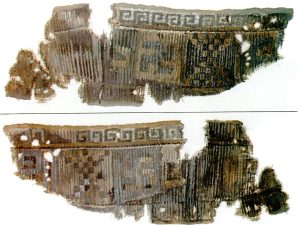Tepe Hemmat, Salāleh, Moghānتپه همت سلاله، دشت مغان
Location: Tepe Hemmat is a natural hill east of the village of Salāleh, in northwestern Iran, Ardabil Province.
39° 2’56.81″N 48°16’22.20″E
Historical Period
Parthian
History and description
Tepe Hemmat is a natural hill of 25 m high and 45 m long on the west side of a watercourse named Salāleh, near a village of the same name. Excavations on the west slope of Tepe Memmat yielded six pithos burial tombs placed at a depth of 3 m under the present-day ground. The terracotta pathos jars were all sealed with a layer of lime or a piece of heavy stone. Inside two of them under the head of the dead, there were two silvers coins of Gudarz (51-41 A.D.) and Vologases I (58-78 A.D.). Fragments of a rug in wool with geometric motifs and parts of a basket in reed were also found in burials. One of the skeletons has preserved its hair that has been retrieved almost in full. Other grave goods consist of pottery vessels and a few personal ornaments in bronze or iron.
Ayri Zamin was excavated by Seyfollah Kambakhshs Fard on behalf of the Iranian Department of Archaeology in 1967.
Finds
Large terracotta jars are used as burial containers. Plain pottery vessels and personal ornaments in bronze or in iron. A piece of rug in wool, a piece of a basket in reed, human hair, silver coins of the Parthian period.
Bibliography
S. Kambakhsh Fard, Parthian Pithos-Burials at Germi (Azarbaijan), Tehran, 1998. In Persian with a summary in English
Author: Ali Mousavi
Originally published: May 27, 2022
Last updated: September 19, 2024


































































































































